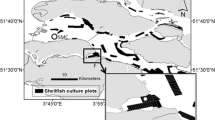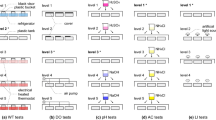Abstract
Handling freshwater mussels may have negative impacts on their survival, growth, or reproduction, and this may affect our interpretation of how mussels respond to research and conservation actions. The goal of this study was to investigate how repeated dislodgement and emersion during handling affects survival and growth of plain pocketbook Lampsilis cardium. Sixty mussels were exposed to one of the four handling rates: (1) control (no handling), (2) handled every other week, (3) handled once per week, or (4) handled twice per week, during an 85-day laboratory experiment in 2017. Absolute daily growth rates were compared among control and treatment group mussels. Growth rates were positive for > 98% of mussels and no mortality occurred. A likelihood ratio test indicated that growth rates did not differ among treatment groups (χ2 (3) = 1.32, P = 0.72). The best growth rate model was an intercept-only model which predicted that an average mussel grew 0.0088 mm/day (95% confidence interval 0.0070–0.0106). Our results suggest that L. cardium survival and growth is not compromised by short-term, repeated handling as often as twice per week, but consideration of handling procedures and mussel characteristics is necessary to fully understand how handling may affect other mussels.



Similar content being viewed by others
Data availability
All data generated or analyzed during this study are included in this published article [and its supplementary information files].
References
Allen, D. C. & C. C. Vaughn, 2009. Burrowing behavior of freshwater mussels in experimentally manipulated communities. Journal North American Benthological Society 28: 93–100.
Arbuckle, K. E. 2000. Statewide assessment of freshwater mussels (Bivalvia: Unionidae) in Iowa streams. Master’s thesis. Iowa State University, Ames.
Augspurger, T., A. E. Eller, M. C. Lack, W. G. Cope & F. J. Dwyer, 2003. Water quality guidance for protection of freshwater mussels (Unionidae) from ammonia exposure. Environmental Toxicology and Chemistry 22: 2569–2575.
Barnes, D. W., 1823. On the genera Unio and Alasmodonta; with introductory remarks. American Journal of Science and Arts 6(107–127): 258–280.
Barnhart, M. C., 2005. Buckets of muckets: a compact system for rearing juvenile freshwater mussels. Aquaculture 254: 227–233.
Barnhart, M. C., W. R. Haag & W. N. Roston, 2008. Adaptations to host infection and larval parasitism in Unionoida. Journal of the North American Benthological Society 27: 370–394.
Bartsch, M. R., D. L. Waller, W. G. Cope & S. Gutreuter, 2000. Emersion and thermal tolerances of three species of unionid mussels: survival and behavioral effects. Journal of Shellfish Research 19: 233–240.
Bates, D. M., M. Maechler, B. Bolker & S. Walker, 2015. Fitting linear mixed-effects models using lme4. Journal of Statistical Software 67: 1–48.
Beutler, C. & M. Esposito, 2017. Annual drinking water quality report. Lincoln Public Works and Utilities, Lincoln.
Bogan, A. E., 1993. Freshwater bivalve extinctions (Mollusca: Unionoida): a search for causes. American Zoologist 33: 599–609.
Bolden, S. R. & K. M. Brown, 2002. Role of stream, habitat, and density in predicting translocation success in the threatened Louisiana pearlshell, Margaritifera hembeli (Conrad). Journal North American Benthological Society 21: 89–96.
Bolker, B. M., M. E. Brooks, C. J. Clark, S. W. Geange, J. R. Poulsen, M. H. H. Stevens & J. S. S. White, 2009. Generalized linear mixed models: a practical guide for ecology and evolution. Trends in Ecology and Evolution 24: 127–135.
Carella, F., G. Villari, N. Maio & G. De Vico, 2016. Disease and disorders of freshwater unionid mussels: a brief overview of recent studies. Frontiers in Physiology 7: 1–8.
Carey, C. S., J. W. Jones, R. S. Butler & E. M. Hallerman, 2015. Restoring the endangered oyster mussel (Epioblasma capsaeformis) to the upper Clinch River, Virginia: an evaluation of population restoration techniques. Restoration Ecology 23: 447–454.
Cope, W. G. & D. L. Waller, 1995. Evaluation of freshwater mussel relocation as a conservation and management strategy. Regulated Rivers: Research & Management 11: 147–155.
Dag, O., A. Dolgun & N. M. Konar, 2018. Onewaytests: an R package for one-way tests in independent groups design. The R Journal 10: 175–199.
Dunn, H. L., B. E. Sietman & D. E. Kelner. 1999. Proceedings of the first Freshwater Mollusk Conservation Society symposium. Ohio Biological Survey, Columbus, Ohio.
Durfor, C. M. & E. Becker. 1964. Public water supplies of the 100 largest cities in the United States. U.S. Geological Survey Water-Supply Paper 1812.
FMCS (Freshwater Mollusk Conservation Society), 2016. A national strategy for the conservation of native freshwater mollusks. Freshwater Mollusk Biology and Conservation 19: 1–21.
Fox, J. & S. Weisberg, 2011. An R companion to applied regression, 2nd ed. Sage Publications, Thousand Oaks.
Ganser, A. M., T. J. Newton & R. J. Haro, 2013. The effects of elevated water temperature on native juvenile mussels: implications for climate change. Freshwater Science 32: 1168–1177.
Ganser, A. M., T. J. Newton & R. J. Haro, 2015. Effects of elevated water temperature on physiological responses in adult freshwater mussels. Freshwater Biology 60: 1705–1716.
Graf, D. L. & K. S. Cummings, 2007. Review of the systematics and global diversity of freshwater mussel species (Bivalvia: Unionoida). Journal of Molluscan Studies 73: 291–314.
Haag, W. R., 2009. Extreme longevity in freshwater mussels revisited: sources of bias in age estimates derived from mark-recapture experiments. Freshwater Biology 54: 1474–1486.
Haag, W. R. & M. L. Warren Jr., 2003. Host fishes and infection strategies of freshwater mussels in large Mobile Basin streams, USA. Journal of the North American Benthological Society 22: 78–91.
Haag, W. R. & A. M. Commens-Carson, 2008. Testing the assumption of annual shell ring deposition in freshwater mussels. Canadian Journal of Fisheries and Aquatic Sciences 65: 493–508.
Haag, W. R. & J. D. Williams, 2014. Biodiversity on the brink: an assessment of conservation strategies for North American freshwater mussels. Hydrobiologia 735: 45–60.
Haag, W. R., D. J. Berg, D. W. Garton & J. L. Farris, 1993. Reduced survival and fitness in native bivalves in response to fouling by the introduced zebra mussel (Dreissena polymorpha) in western Lake Erie. Canadian Journal of Fisheries and Aquatic Sciences 50: 13–19.
Hinch, S. G., R. C. Bailey & R. H. Green, 1986. Growth of Lampsilis radiata (Bivalvia: Unionidae) in sand and mud: a reciprocal transplant experiment. Canadian Journal of Fisheries and Aquatic Sciences 43: 548–552.
Hua, D., Y. Jiao, R. Neves & J. Jones, 2015. Use of PIT tags to assess individual heterogeneity of laboratory-reared juveniles of the endangered Cumberlandian combshell (Epioblasma brevidens) in a mark-recapture study. Ecology and Evolution 5: 1076–1087.
Larson, J. H., N. L. Eckert & M. R. Bartsch, 2014. Intrinsic variability in shell and soft tissue growth of the Freshwater mussel Lampsilis siliquoidea. PLOS ONE 9: 1–8.
Lea, I., 1831. Observations on the naiades, and descriptions of new species of that and other families. Transactions of the American Philosophical Society 4: 63–121.
Leferve, G. & W. C. Curtis, 1911. Metamorphosis without parasitism in the Unionidæ. Science 33: 863–865.
Liu, H. 2015. Comparing Welch’s ANOVA, a Kruskal-Wallis test and traditional ANOVA in case of heterogeneity of variance. Master’s thesis. Virginia Commonwealth University, Richmond, Virginia.
Lopes-Lima, M., L. E. Burlakova, A. Y. Karatayev, K. Mehler, M. Seddon & R. Sousa, 2018. Conservation of freshwater bivalves at the global scale: diversity, threats and research needs. Hydrobiologia 810: 1–14.
Negishi, J. N. & Y. Kayaba, 2009. Effects of handling and density on the growth of the unionoid mussel Pronodularia japanensis. Journal of the North American Benthological Society 28: 821–831.
Newton, T. J., J. W. Allran, J. A. O’Donnell, M. R. Bartsch & W. B. Richardson, 2003. Effects of ammonia on juvenile unionid mussels (Lampsilis cardium) in laboratory sediment toxicity tests. Environmental Toxicology and Chemistry 22: 2554–2560.
Newton, T. J., S. J. Zigler, J. T. Rogala, B. R. Gray & M. Davis, 2011. Population assessment and potential functional roles of native mussels in the Upper Mississippi River. Aquatic Conservation: Marine and Freshwater Ecosystems 21: 122–131.
NNMCC (National Native Mussel Conservation Committee), 1998. National strategy for the conservation of native freshwater mussels. Journal of Shellfish Research 17: 1419–1428.
R Core Team. 2017. R: A language and environment for statistical computing. R Foundation for Statistical Computing, Vienna, Austria. https://www.R-project.org/.
Rafinesque, C. S. 1820. Monographie des coquilles bivalves fluviatiles de la Rivie`re Ohio, contenant douze genres et soixante-huit espe`ces. Annales Ge´ne´rales des Sciences Physiques a Bruxelles 5: 287–322.
Ricciardi, A. & J. B. Rasmussen, 1999. Extinction rates of North American freshwater fauna. Conservation Biology 13: 1220–1222.
Rosenthal, J. A., 1996. Qualitative descriptors of strength of association and effect size. Journal of Social Service Research 21: 37–59.
Sarrazin, F. & S. Legendre, 2000. Demographic approach to releasing adults versus young in reintroductions. Conservation Biology 14: 488–500.
Say, T., 1817. Descriptions of seven species of American fresh water and land shells, not noticed in the systems. Journal of the Academy of Natural Sciences in Philadelphia 1: 13–18.
Strayer, D. L., 2008. Freshwater mussel ecology: a multifactor approach to distribution and abundance. University of California Press, Berkeley.
Strayer, D. L. & D. G. Smith, 2003. A guide to sampling freshwater mussel populations. American Fisheries Society, Bethesda.
Trapletti, A. & K. Hornik. 2018. tseries: time series analysis and computational finance. R package version 0.10–45.
Venables, W. N. & C. M. Dichmont, 2004. GLMs, GAMs and GLMMs: an overview of theory for applications in fisheries research. Fisheries Research 70: 319–337.
Waller, D. L., J. J. Rach & W. G. Cope, 1995. Effects of handling and aerial exposure on the survival of unionid mussels. Journal of Freshwater Ecology 10: 199–207.
Waller, D. L., S. Gutreuter & J. J. Rach, 1999. Behavioral responses to disturbance in freshwater mussels with implications for conservation and management. Journal North American Benthological Society 18: 381–390.
Waller, D. L., M. R. Bartsch, K. T. Fredricks, L. A. Bartsch, S. M. Schleis & S. H. Lee, 2017. Effects of carbon dioxide on juveniles of the freshwater mussel (Lampsilis siliquoidea [Unionidae]). Environmental Toxicology and Chemistry 36: 671–681.
Wang, N., C. G. Ingersoll, I. E. Greer, D. K. Hardesty, C. D. Ivey, J. L. Kunz, W. G. Brumbaugh, F. J. Dwyer, A. D. Roberts, T. Augspurger, C. M. Kane, R. J. Neves & M. C. Barnhart, 2007. Chronic toxicity of copper and ammonia to juvenile freshwater mussels (Unionidae). Environmental Toxicology and Chemistry 26: 2048–2056.
Welch, B. L., 1951. On the comparison of several mean values: an alternative approach. Biometrika 38: 330–336.
Wickham, H., 2017. Tidyverse: easily install and load ‘Tidyverse’ packages. R package version 1(1): 1.
Williams, J. D., M. L. Warren Jr., K. S. Cummings, J. L. Harris & R. J. Neves, 1993. Conservation status of freshwater mussels of the United States and Canada. Fisheries 18: 6–22.
Zar, J. H., 1999. Biostatistical analysis, 4th ed. Prentice Hall, Englewood Cliffs.
Acknowledgements
We thank the U.S. Fish and Wildlife Service for the state wildlife grant (U-10-R-1) and the Nebraska Game and Parks Commission and Iowa Department of Natural Resources for funding and the opportunity to work with an imperiled species. This project is also based on research that was partially supported by the Nebraska Agricultural Experiment Station with funding from the Hatch Multistate Research capacity funding program (NC-1189) from the USDA National Institute of Food and Agriculture. We are grateful to Bryan Sweet and staff of the North Platte Fish Hatchery for providing the mussels and for their continued support. We wish to thank Jamilynn Poletto for providing the laboratory, various supplies, and advice on experimental design. Thank you to Christopher Chizinski, Mark Kaemingk, and Drew Tyre for guidance with data analyses. Thank you to Manuel Lopes-Lima and two anonymous reviewers for their insightful comments on this manuscript.
Author information
Authors and Affiliations
Corresponding author
Additional information
Handling editor: Manuel Lopes Lima
Publisher's Note
Springer Nature remains neutral with regard to jurisdictional claims in published maps and institutional affiliations.
Electronic supplementary material
Below is the link to the electronic supplementary material.
Rights and permissions
About this article
Cite this article
Ohlman, L.M., Pegg, M.A. Handling effects on survival and growth of plain pocketbook Lampsilis cardium (Rafinesque, 1820) freshwater mussels. Hydrobiologia 847, 457–467 (2020). https://doi.org/10.1007/s10750-019-04106-y
Received:
Revised:
Accepted:
Published:
Issue Date:
DOI: https://doi.org/10.1007/s10750-019-04106-y




